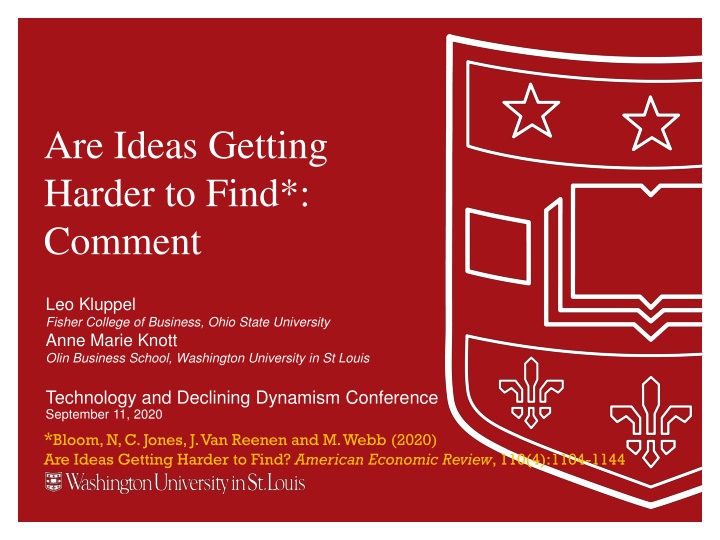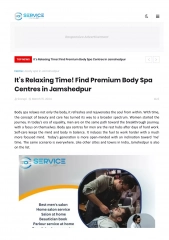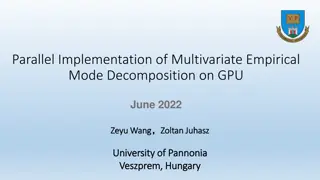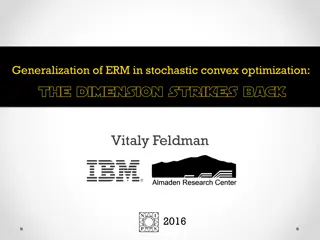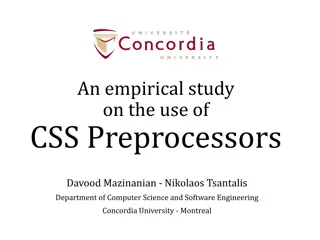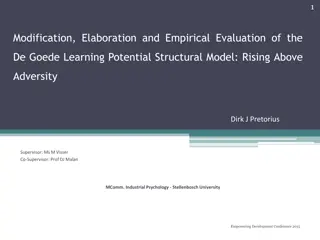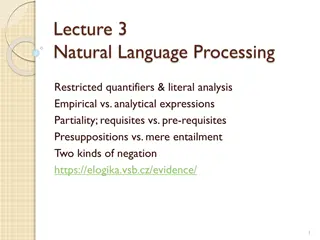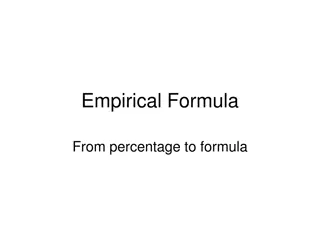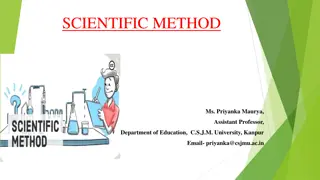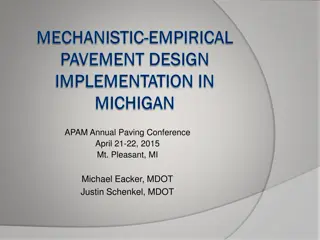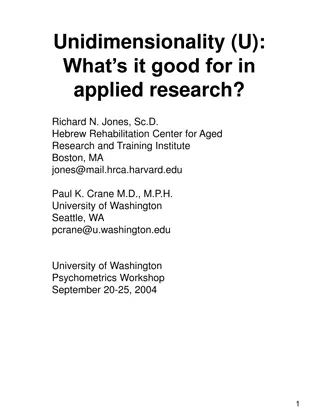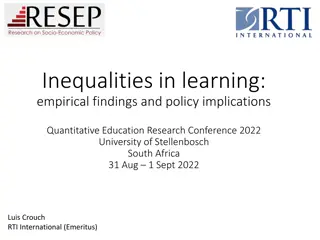Are Ideas Getting Harder to Find? Empirical Insights and Implications
This discussion explores the phenomenon of ideas becoming harder to find, as discussed in the research by Bloom, Jones, Van Reenan, and Webb. The analysis delves into the implications of declining research productivity and challenges in identifying new ideas within the current technological landscape. By examining the empirical records and models presented, the commentary sheds light on the evolving dynamics of idea generation and the potential exogenous nature of technological change.
Download Presentation

Please find below an Image/Link to download the presentation.
The content on the website is provided AS IS for your information and personal use only. It may not be sold, licensed, or shared on other websites without obtaining consent from the author.If you encounter any issues during the download, it is possible that the publisher has removed the file from their server.
You are allowed to download the files provided on this website for personal or commercial use, subject to the condition that they are used lawfully. All files are the property of their respective owners.
The content on the website is provided AS IS for your information and personal use only. It may not be sold, licensed, or shared on other websites without obtaining consent from the author.
E N D
Presentation Transcript
Are Ideas Getting Harder to Find*: Comment Leo Kluppel Fisher College of Business, Ohio State University Anne Marie Knott Olin Business School, Washington University in St Louis Technology and Declining Dynamism Conference September 11, 2020 *Bloom, N, C. Jones, J. Van Reenen and M. Webb (2020) Are Ideas Getting Harder to Find? American Economic Review, 110(4):1104-1144
The puzzle: Empirical record at odds with scale effects prediction 5.0% 1200 R&D scientists and engineers FTE (1000) REal GDP Growth (5 year mean) 4.5% 1000 4.0% 3.5% 800 3.0% 2.5% 600 2.0% 400 1.5% 1.0% 200 0.5% 0.0% 0 1971 1974 1977 1980 1983 1986 1989 1992 1995 1998 2001 2004 2007 2010 2013 2016 Real GDP growth 5yr mean R&D Labor
Leading explanation: R&D Getting Harder (Jones 1995, Gordon 2016) Jones formalization eliminates Romer s scale effects prediction, by adding Fishing out effect ( )- probability of finding new ideas is declining in the stock of ideas Externalities ( )- higher likelihood of duplicate efforts Romer: ?= ? ?A Revision: ? = ??? Implication: Technological change is exogenous ?? 1
Bloom, Jones, VanReenan, Webb (2020) Examine Jones Develop measure: firm research productivity: = (At /At))/HA = g/HA Estimate decline in for Compustat firms Conclusion: Ideas are getting harder to find virtually everywhere we look Don t test fishing out ( )
Empirical model of Jones using research productivity To test fishing out, need to distinguish between and Growth in Jones Growth in BJVW ?? -1 ? = ??? ? = ??? Set the two expressions for g equal to one another ???= ??? ? = ??? ?? 1 ? 1? 1 Empirical Model: ln(Research productivity) = 0 + 1 ln(HA) + 2 ln(At)+ i + dt + it Then = + and = + Fishing out: < 1
Data and Measures Research Productivity, Data and code available through the American Economic Review data-availability policy. https://www.aeaweb.org/articles?id=10.1257/aer.20180338 We form firm-year 10-year moving average for sales (versus firm-decade measures) We confirm decadal summaries of these firm-year measures match those in BJVW Table 4. Knowledge Stock, A 1) Identify all technology groups cited by all patents filed in year t (that are ultimately granted). 2) Group stock = sum over all years of patents in that group, depreciated at an annual rate of 20% 3) KSPatp,= sum of stocks in its groups, weighted by each group s share of that patent s citations. The three proxies PatentSumKnowledgeStock is the total knowledge stocks across all patents filed by firm i in year t: pt??????. PatentKnowledgeStockit is the average knowledge stock per patent per firm i filed in year t: ( pt??????)/ #patentst CitationKnowledgeStock averages out the ?????? of its citations. Scientific Labor, HA R&Dt /(mean wage, BS degree, male) Combined dataset: All firms conducting R&D and filing patents 1983-2015 (~34,000 firm-year observations)
Results: Test of Fishing Out, Research Productivity, a (1) -1.09 (0.01) 0.22 (0.03) (2) -1.10 (0.01) (0.01) (0.01) (0.01) (0.01) 0.20 (0.03) 0.19 0.15 (0.02) (0.02) (3) -1.09 (4) -1.10 (5) -1.09 6) Ln(Scientists) Ln(CitationKnowledgeStock) Ln(PatentKnowledgeStock) Ln(PatentSumKnowledgeStock) Constant -1.09 0.01 (0.01) (0.01) -1.95 0.01 -3.78 (0.25) -3.50 (0.25) (0.21) (0.21) (0.12) (0.11) -3.50 -3.15 -1.87 Obs. R-squared Industry FE Year FE Industry-by-year FE 33910 33124 34066 33277 34066 33277 0.82 0.83 0.82 SIC3 SIC4 SIC3 Yes Yes Yes Yes Yes Yes 0.83 SIC4 Yes Yes 0.82 SIC3 Yes Yes 0.83 SIC4 Yes Yes Standard errors are in parenthesis = + = (consistent with duplication of effort) = + = (consistent with spillovers in knowledge production)
Alternative Tack: Test Maximum Maximum Research Productivity, aMAX (2) (3) 0.116 0.040 0.010 (0.145) (0.019) (0.004) -224.71 -77.39 -19.65 (290.54) (38.458) (8.895) (1) (4) 0.004 (0.002) -7.70 (3.22) (5) Year Constant 0.003 (0.001) -5.18 (2.21) Observations R-squared Industry FE 33 0.03 NO 330 0.18 SIC1 1652 0.19 SIC2 5317 0.16 SIC3 8238 0.14 SIC4
Then What Accounts for the Decline in Firms Research Productivity RQ is the firm s output elasticity of R&D, i Decline in firms' R&D productivity 0.70 0.16 0.14 0.60 0.12 where 0.50 0.10 Yi,tis output, Ai is a firm fixed effect Ki,t is capital Li,t is labor Ri,t-1 is lagged R&D Si,t-1 is lagged spillovers Di,t is advertising Idea TFP 0.40 RQ 0.08 0.30 0.06 0.20 0.04 0.10 0.02 Obtained from random coefficients estimation over rolling 7-year windows 0.00 0.00 1972 1974 1976 1978 1980 1982 1984 1986 1988 1990 1992 1994 1996 1998 2000 2002 2004 2006 2008 ideaTFP RQ
Existing Evidence: Firms are Getting Worse at R&D Practice Outsourced R&D Correlation with RQ RQ of outsourced R&D = 0: Thus firm RQ declines linearly in share outsourced (Knott 2020) RQ 40-60% lower than centralized R&D (Cummings 2019) Decreases RQ relative to inside CEOs (Cummings and Knott 2018) Trend since 1980s 6x increase in outsourcing intensity Decentralization 34% decrease in level of centralization 67% increase in share of outside CEOs Outside CEOs
Summary Little evidence R&D has gotten harder suggests spillovers rather than fishing out Max increasing over time particularly across domains Some evidence firms are getting worse at R&D Have increasingly adopted lower practices Implications: Reinforces endogenous growth May be able to revive growth, by restoring firms RQs (reversing firms R&D practices)
